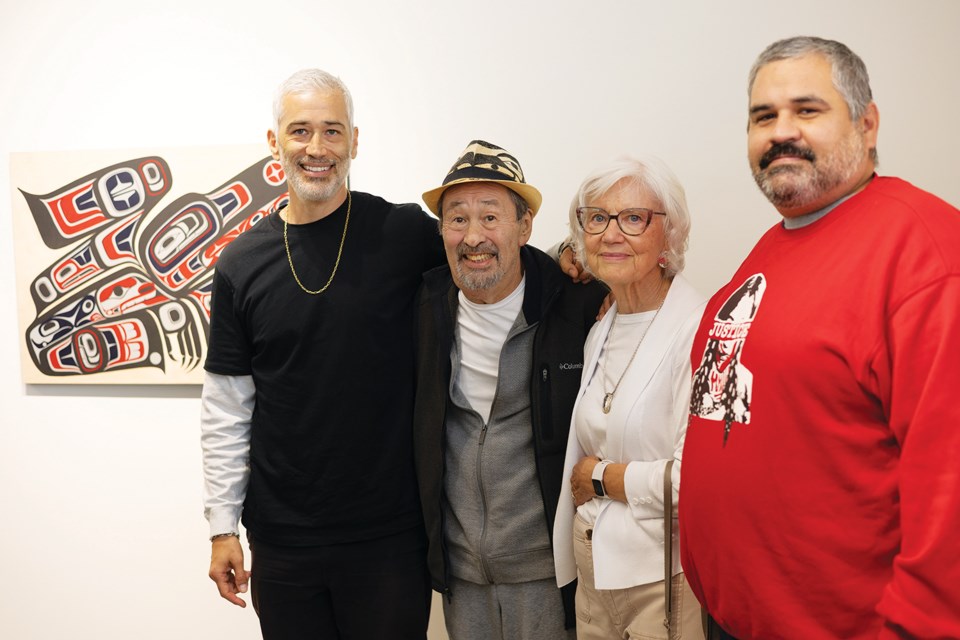A new exhibition embracing relationships and renewal echoes the debut of the Gibsons Public Art Gallery at its present location more than two decades ago.
Painted works by Sechelt-based Heiltsuk artist Bradley Hunt compose the bulk of a showcase titled New Directions: Contemporary Heiltsuk Paintings that opened last week, heralded by a tightly-packed public reception on May 31. Hunt’s sons Shawn and Dean — themselves acclaimed artists and protégés of their father — meanwhile display paintings alongside selections from Hunt’s grandchildren.
The opening evoked the present gallery’s first exhibition in 2003, which highlighted the work of both Bradley and Shawn Hunt alongside a half-dozen other contributors from the Sunshine Coast. “The gallery was started with a group of local citizens envisioning a place for the community to gather and celebrate art just like we are doing today,” said GPAG president Stewart Stinson. The present facility represented a dramatic improvement over its original site: a cramped series of rooms in Molly’s Lane, accessible only by staircase.
Stinson revealed that the Audain Foundation — one of the current show’s sponsors — will also contribute to an upcoming renovation project planned to further increase gallery accessibility.
For the Hunt family, the show reflects renewal and resilience. Shawn Hunt, who apprenticed with his father for five years (and later with Coast Salish painter Lawrence Paul Yuxweluptun), recalled a fateful decision Bradley made in 1985. “That was the year my father stepped away from his teaching career to pursue his true calling as a full-time artist,” he said. “It was a choice filled with uncertainty, yet it reshaped the course of our lives and led our family to this very moment.”
Bradley was born in Waglisla (Bella Bella), a member of the Eagle clan. Armed with degrees from Vancouver Art School and UBC he spent the 1970s and early 1980s teaching elementary students — first in Bella Bella, then in Sechelt. His transformation into a full-time carver sparked immediate recognition: the year after his momentous decision, he exhibited at Expo 86. In 1993 he contributed panels to UBC’s First Nations House of Learning. A few years before the millennium, his totem poles were erected at sites in Whistler and Okinawa, Japan. Working with Gary Kent, he shaped the doors of the Heritage Playhouse in Gibsons.
In 2018, Hunt received the BC Achievement Foundation’s First Nations Art Award. The honour was followed by years of challenges: a cancer diagnosis, COVID-19, and pneumonia. He made the decision to end his carving career.
“But my father is not one to be defined by limitations,” said Shawn Hunt. He urged his father to try something new: painting. “His inspiration ignited,” Shawn added.
The bold, brilliantly-coloured formlines by Hunt (painted in acrylic on wood panels) traverse the mythos of the Heiltsuk Nation in a style inspired by bentwood box design. In Provider a raptor extends its talons over placid waters; in Trickster, the raven is caught in the act of metamorphosis. Hunt’s work is remarkable for its dynamism: timeworn legends are never still. Even in A Quiet Moment, a trio of iconic figures share a canoe journey as their feet, fins and feathers propel the crowded vessel forward.
“The transition to painting wasn’t very hard,” said Bradley Hunt, “because we do a lot of painting in our carving. Box design is a very complex form of the art. What I was trying to do is bring that out, do box design but expand it so people can see that it’s not just a box design but many other things as well.”
Hunt absorbed his knowledge of Heiltsuk iconography through a lifetime of conversations. “I didn’t know that much in the beginning,” he recalled, “I wasn’t really taught anything about the art form, so I had to re-learn all of it.”
Through watercolours and acrylics by grandchildren Naycia, Blayz, and Vayda, his distinctive themes surface in a new generation: Bobcat and Raven travel the forest; a jungle scene thrums with life. “All of art is a form of language,” Hunt explained, “and it’s a great legacy to have my grandchildren and children involved in it.”
New Directions: Contemporary Heiltsuk Paintings continues at the Gibsons Public Art Gallery until June 22.



